Some background may or may not be in order here, so feel free to skip the next section if you want to get to the meat and potatoes of using K&K to decide battles, the idea of having players influencing the game world substantially without playing or any other element.
The Background
The city (or folkhall) of Hammerval lies in the imperial Duchy of Auruxol (also called Goldhook, if you speak English and not a fantasy variant of Latin). It remains one of the most lasting and substantial monuments to the ancient alliance between the city of Miles and the dwarven people. The dwarves of Hammerval are highly Mileanized. Though they are Iron Dwarves of various tribes and though they retain much of their clannish nature, they are more inclined to trust imperial citizens than Iron Dwarves of other folkhalls.
When the House of Galoen were made kings in Thyrnesse, the old family of Auruxol (who had previously given Thyrnesse several kings of their own) was destroyed. The Duchy attached to the royal heartland and Hammerval's Hallkonungr (Hall-Prince) was elevated to chief authority over all the dwarves in the area. However, King Tamerin III gifted Auruxol back to one of its noble families—the Anarjents (who took their name from the royal mint-town of Anarjenor) in return for Darius Anarjent's support in mining gold from the mountains. The dwarven folkhall and its Hallkonungr were given the task of minting and mining all the gold that would flow into the royal (and later imperial) coffers. Suffice to say, Hammerval, as the center of all gold minting activity in the empire, is very important to the emperor.
Darius Anarjent, Lord of the Coffers, is never present in his duchy to rule it. This would normally be no major issue, but of late the orcish population that dwells high upon and deep beneath the Auruxol Mountains has exhibited the alarming propensity of raiding the outlying mines and homesteads of Hammerval.
Operating under the well-founded assumption that an orcish chief is attempting to make a name for himself and, in so doing, gather up more and more of the vast but fractured orc peoples. The Hallkonung's fear is that the orcs will ride from success to success, growing in ferocity, training, and number, until they spill forth from the mountains and sweep into Hammerval and the Hammerdeep Vale proper. This isn't as alarmist as it seems: forty or fifty years ago, in the emperor's youth, such a thing did happen, albeit on the eastern side of the mountains.
The PCs are dealing with this situation currently, having been dispatched by the emperor to see if the rumors of the raids are true and, if so, to inform him what they believe should be done. The PCs have just finished scouting out the situation and are even now delivering their report to the emperor. Meanwhile...
The Skirmishes
We used K&K to simulate the Gaethaff Elda Goldhar (essentially the chief defensive general of a dwarven folkhall) doing battle against an advance party of orcish raiders, defending a minehead, and then marching on the advance party's camp.
One player took control of the dwarves and another of the orcs. The result was a mixed bag, with the dwarves winning an overall victory, but the Gaethaff dying in an ignominious and inglorious fashion.
The Idea
After playing through these skirmishes we discussed the way K&K represents the granularity of combat. It doesn't represent it as well as AD&D; though your men are named, they die relatively easily. There is, of course, no consideration of improvisation. Death or incapacity are always a hair's breadth away. We've determined that we don't want to use this for any skirmish in which the PCs are actually present, because it will give them very short shrift.
Here are some rules we did decide on for when they aren't present:
Orcs receive a -1 morale penalty to all rolls (as per the K&K morale system) if they are forced to fight in daylight.
Dwarves move at -2" (or as though they had +2 armor).
Many more of the changes (how high the orcs morale are, the essential stats of each unit) can already be determined within the ambit of K&K without making major exceptions.
Our other idea for incorporation is to lift the AI rules that govern how units respond to orders they've been given (hold here, defend here, attack until) when their "commander" (IE, the PC) is no longer present. This will definitely be made use of during large scale battles.
Long live the union of K&K and D&D!
